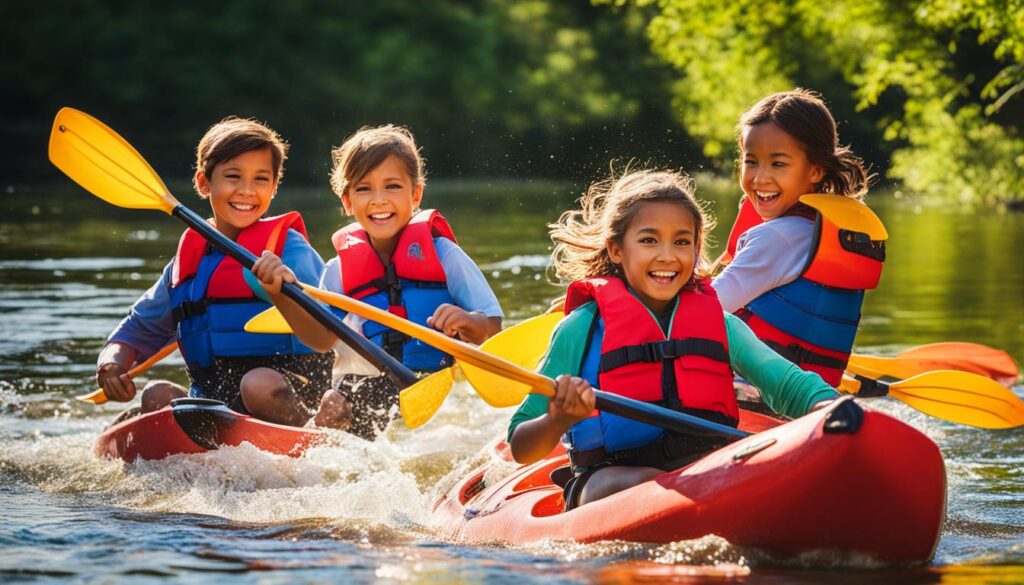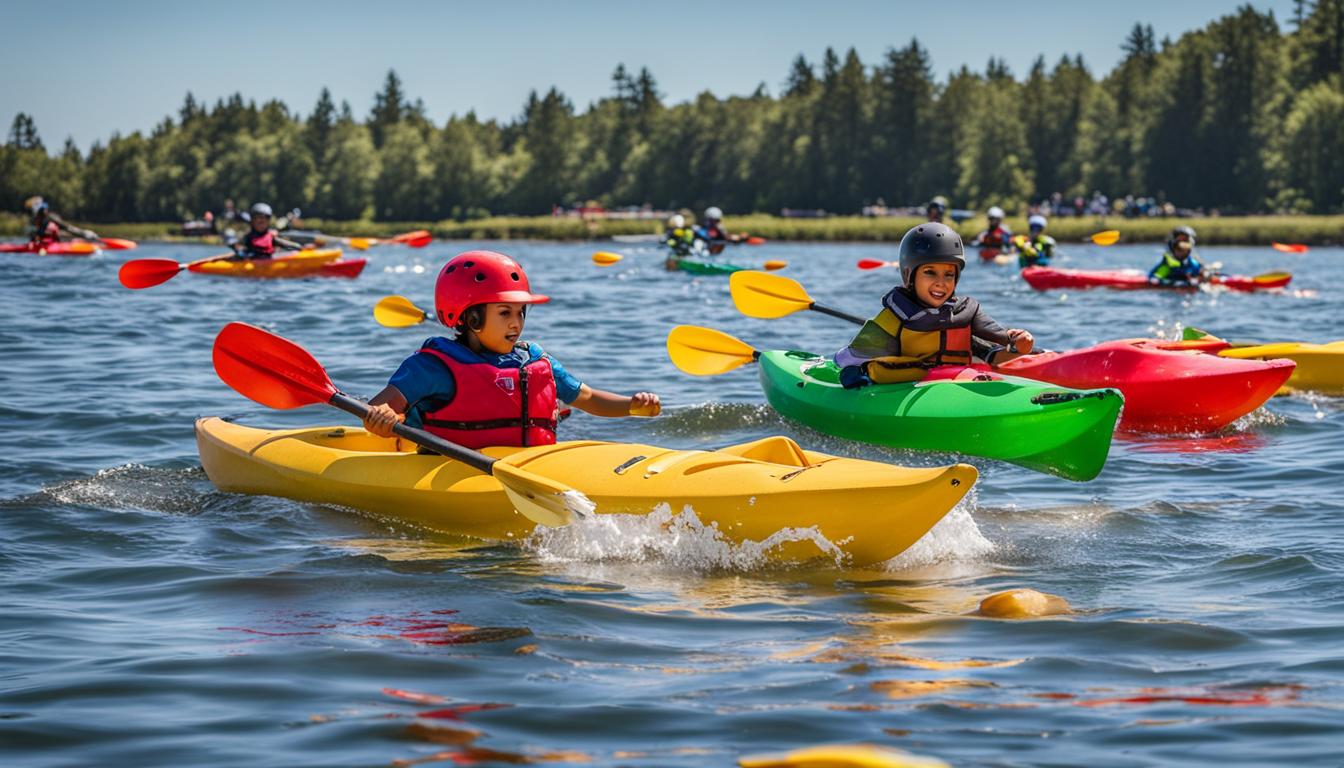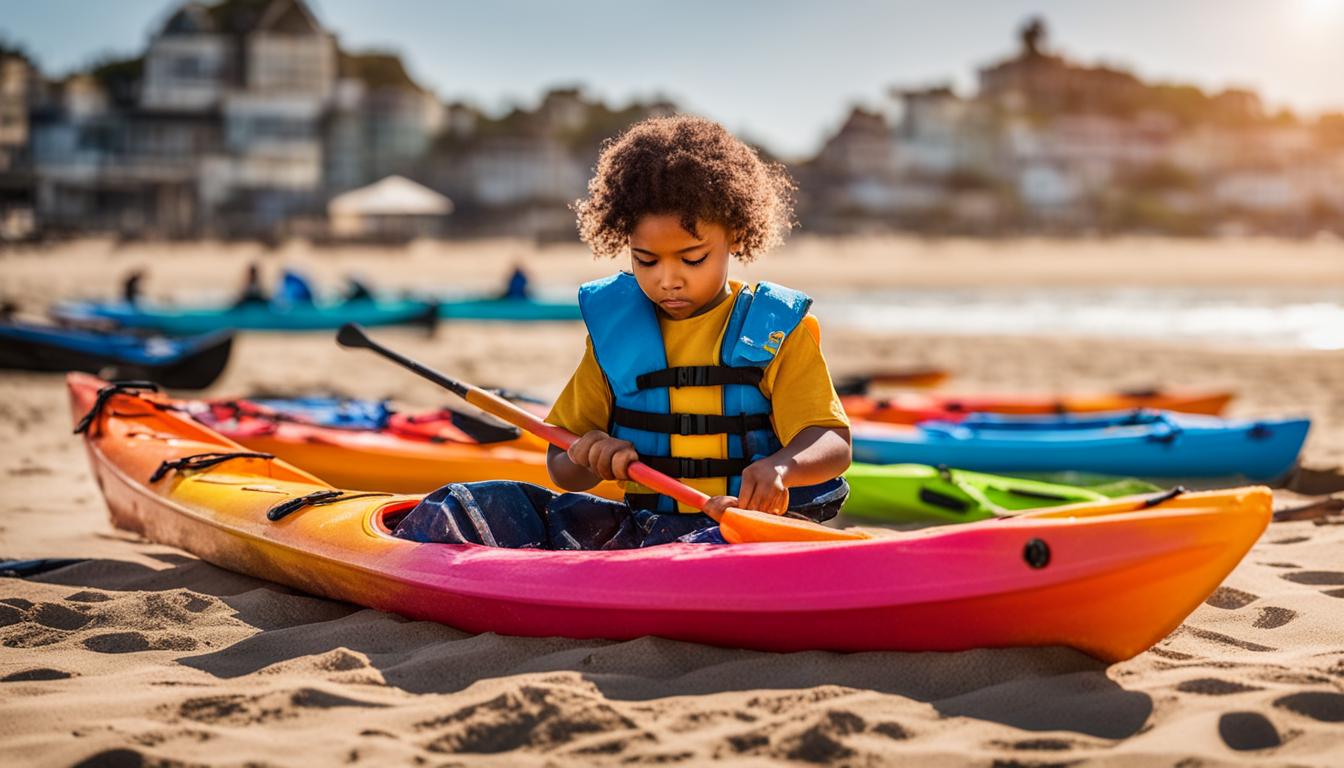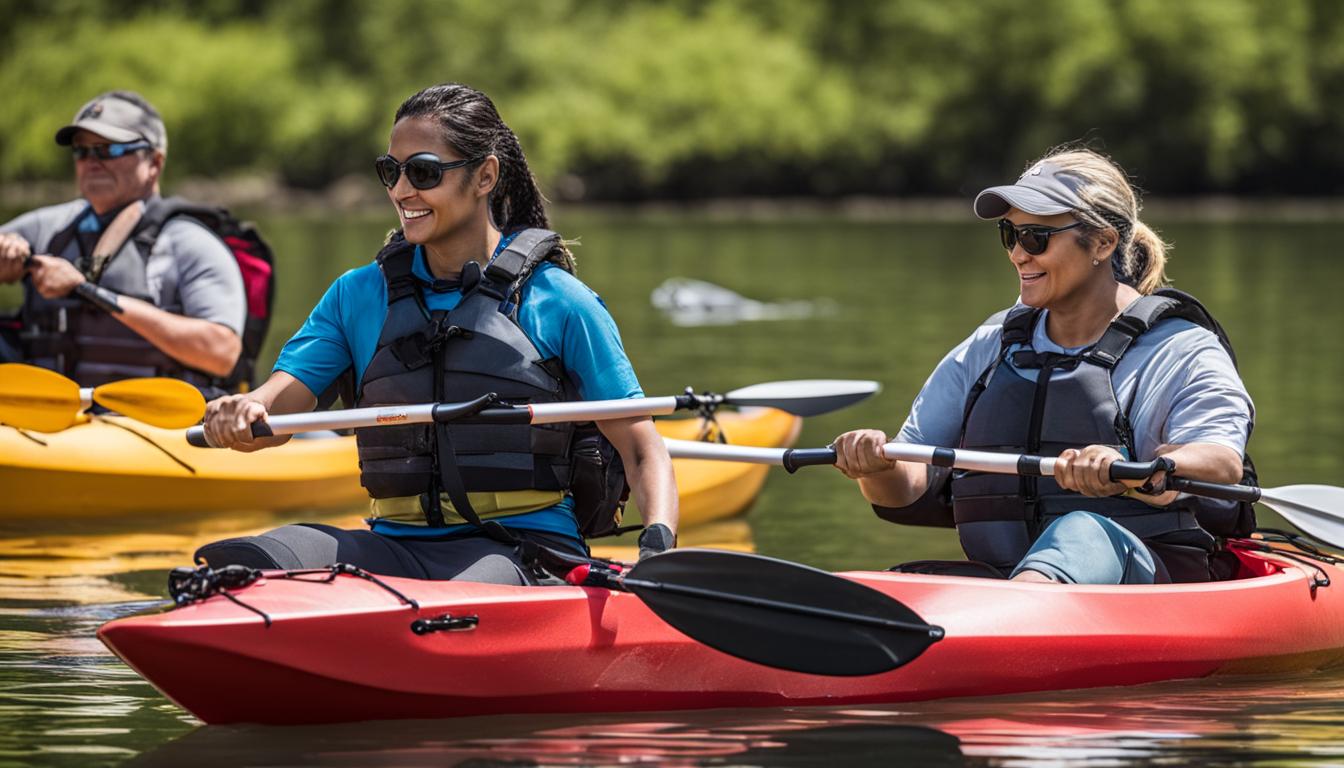Kayaking has become a popular activity for children as it provides a thrilling and engaging experience. Engaging in kayaking games and activities allows children to have fun while building various skills. These games can be enjoyed both in the water and on land, providing a well-rounded experience for young paddlers.
Key Takeaways:
- Interactive kayaking activities for children offer a balance of fun and learning.
- Kayaking games can promote teamwork, physical activity, and environmental awareness.
- Engaging children in kayaking activities helps develop important life skills.
- Ensure safety by providing appropriate gear and clear instructions.
- Organize games that are engaging, inclusive, and age-appropriate.
Kayaking Games in the Water
When it comes to kayaking games for kids, the water is the perfect playground. These interactive paddling games not only provide countless hours of fun but also help children develop their kayaking skills. One popular game is kayak basketball, where teams compete to shoot a ball into each other’s kayaks. It’s a great way to improve accuracy and coordination while enjoying the thrill of competition.
Another exciting game is kayak polo, where teams score points by throwing a ball around and into the opponent’s goal. It’s a fantastic way to enhance teamwork and strategy while paddling. For those looking for a challenge, games like tag and round and round can test paddling speed and agility.
But it’s not just about the fun and games; kayaking challenge activities for kids can also help develop trust and balance. The “walk on the plank” game is a trust-building activity where children must walk on a narrow plank while their teammates help maintain balance. It fosters teamwork, communication, and coordination, making it a valuable addition to any kayaking adventure.
Table: Popular Kayaking Games in the Water
| Game | Description |
|---|---|
| Kayak Basketball | Teams compete to shoot a ball into each other’s kayaks. |
| Kayak Polo | Teams score points by throwing a ball around and into the opponent’s goal. |
| Tag | A thrilling game of chasing and being chased while paddling. |
| Round and Round | A race to see who can paddle around a designated course the fastest. |
| Walk on the Plank | A trust-building activity where children walk on a narrow plank with the help of their teammates. |
Educational Kayaking Games for Young Paddlers
While kayaking is primarily a water-based activity, there are also plenty of educational and nature-based games that can be enjoyed on land during kayak outings. These games provide a unique opportunity for young paddlers to learn about their surroundings, develop new skills, and deepen their appreciation for the environment.
Exploring Nature with Scavenger Hunt
One popular game for young paddlers during kayak outings is a nature-themed scavenger hunt. This game encourages children to explore their surroundings, learn about different plants and animals, and foster a sense of curiosity. Prior to the outing, create a list of items for the children to find, such as specific types of leaves, rocks, or animal tracks. Provide them with a small bag or box to collect their findings. This activity not only engages children in a fun and educational game but also helps them connect with the natural world.
Engaging children in educational kayaking games not only provides entertainment but also fosters a love for nature and promotes environmental awareness.
The Animal Kingdom Memory Game
The Animal Kingdom Memory Game is another activity that can be enjoyed on land during a kayak outing. Prior to the trip, create a set of cards featuring different animals that are native to the area. Place the cards face down on the ground, and have the children take turns flipping two cards at a time to find a matching pair. This game not only enhances memory and cognitive skills but also teaches children about the local wildlife and encourages them to learn more about different species.

Outdoor Yoga and Stretching
Engaging in outdoor yoga and stretching exercises is an excellent way to enhance the land-based portion of a kayak outing. Find a scenic spot on land where children can practice various yoga poses and stretches. Encourage them to connect with their breath, focus their attention, and relax in nature’s serenity. This activity not only promotes physical health and flexibility but also provides a sense of calm and mindfulness.
| Benefits of Educational Kayaking Games for Young Paddlers |
|---|
| Enhances environmental awareness and appreciation |
| Fosters curiosity and love for nature |
| Promotes cognitive development and memory skills |
| Improves physical health and flexibility |
| Encourages mindfulness and relaxation in natural surroundings |
Engaging children in educational kayaking games not only provides entertainment but also fosters a love for nature and promotes environmental awareness. These nature-based games enhance their cognitive skills, physical health, and overall well-being. By incorporating land-based activities into kayak outings, young paddlers can have a well-rounded experience that combines fun, education, and a deeper connection with the natural world.
Canoe Games for All Ages
Canoe games are not limited to a specific age group and can be enjoyed by children of all ages. These interactive activities add an element of fun and excitement to kayaking trips, engaging children during their time on the water. Kayaking treasure hunts, in particular, are a popular game that combines adventure and teamwork. Children can search for hidden treasures while paddling their canoes, enhancing their problem-solving and navigation skills.
In addition to treasure hunts, there are other entertaining games that can be played in canoes. One such game is “Race to a Dozen,” which involves completing various tasks as quickly as possible. This game promotes teamwork and encourages participants to think strategically to complete the challenges. Another exciting game is “Gunwale Bobbing,” where two players attempt to make each other lose balance and fall into the water. This game not only tests players’ balance and coordination but also adds an element of friendly competition.
| Canoe Game | Objective | Benefit |
|---|---|---|
| Race to a Dozen | Complete tasks quickly | Teamwork and strategic thinking |
| Gunwale Bobbing | Make opponents lose balance | Balance and coordination |
| Sticky Situation | Grab pieces of sticky tape | Hand-eye coordination |
| Ultimate Canoe Frisbee | Score points by throwing a Frisbee | Throwing accuracy and teamwork |
| Clowns | Perform entertaining tricks | Creativity and showmanship |
These canoe games provide not only physical activity but also opportunities for children to develop important life skills. From fostering teamwork and communication to improving balance and coordination, these games offer a well-rounded experience for young paddlers. Whether it’s a kayaking adventure or a school camp program, incorporating these games ensures that children have an engaging and enjoyable time on the water.
Kayaking Games for School Groups
Kayaking games can be a fantastic addition to school camp programs, providing a creative and engaging experience for students. Not only do these games offer a fun break from traditional activities, but they also promote teamwork, physical exercise, and problem-solving skills. Whether you’re planning a day trip or an extended kayak outing, incorporating these games into your itinerary can enhance the overall experience for school groups.
Warm Up
Before diving into the kayaking adventure, it’s crucial to warm up and prepare students for physical activity. This game is designed to get their bodies moving and focus their attention on the upcoming challenges. You can lead students through a series of stretches, light exercises, or quick team-building activities to ensure they are ready for the kayaking journey.
Rafting Up
Rafting Up is a game that allows students to participate in various activities while their kayaks are held together in a raft-like formation. This game promotes teamwork and cooperation as students work together to complete tasks or play interactive games such as passing a ball around the raft without dropping it. Rafting Up also provides an opportunity for students to socialize and build relationships with their peers.
Swap Seats and Stand Up
This game challenges students to switch seats with their teammates while keeping their balance in the kayak. It requires coordination, communication, and the ability to adapt quickly. Students must work together to ensure everyone can successfully change seats without tipping the kayak. Additionally, the game can be modified to include standing up in the kayak, further testing their balance and stability.
Canoe Polo
Canoe Polo is an exciting game that combines kayaking and polo elements. Students are divided into two teams and compete to score goals by throwing a ball into the opposing team’s net. This game not only improves students’ paddling skills and coordination but also encourages teamwork, strategy, and healthy competition.
Circle Work and Tag
Circle Work and Tag are great games to incorporate during breaks or as a way to energize students. Circle Work involves paddling in a circle formation, allowing students to practice their paddling techniques and coordination. Tag, on the other hand, adds an element of excitement and physical activity as students chase each other while maneuvering their kayaks. These games provide a refreshing break from the routine and keep students engaged throughout the kayaking trip.
| Game | Objective | Skills Developed |
|---|---|---|
| Warm Up | Prepare students for physical activity | Flexibility, coordination, teamwork |
| Rafting Up | Promote teamwork and socialization | Cooperation, communication, problem-solving |
| Swap Seats and Stand Up | Test balance and coordination | Adaptability, teamwork, balance |
| Canoe Polo | Improve paddling skills and encourage teamwork | Paddling technique, coordination, strategy |
| Circle Work and Tag | Add excitement and physical activity to the trip | Paddling technique, coordination, endurance |
Benefits of Kayaking Games for Kids
Engaging children during kayak trips with educational kayaking games can have numerous benefits for their development and overall experience. These games not only provide a fun and enjoyable activity but also offer opportunities for children to learn valuable skills and gain a deeper appreciation for nature.
Promotes Teamwork and Communication
Kayaking games require children to work together and communicate effectively to achieve their goals. Whether it’s playing kayak basketball or participating in team-building activities, children learn the importance of collaboration, coordination, and effective communication. These skills are transferable to various aspects of their lives, such as school projects or team sports.
Improves Muscle Strength and Coordination
As children paddle and maneuver their kayaks during games, they engage multiple muscle groups, including their arms, shoulders, and core. This physical activity helps improve muscle strength, endurance, and overall coordination. Regular participation in kayaking games can contribute to the development of a healthy and active lifestyle for children.
Enhances Environmental Awareness
Kayaking games often take place in natural settings, such as rivers, lakes, or coastal areas. Through these games, children have the opportunity to interact with their surroundings, observe wildlife, and learn about the importance of environmental conservation. By fostering a sense of stewardship and appreciation for nature, kayaking games can help instill a lifelong commitment to protecting the environment.
Overall, incorporating kayaking games into children’s activities offers a holistic approach to their development. These games not only provide entertainment but also foster teamwork, physical fitness, and environmental consciousness. So, the next time you plan a kayak trip with children, make sure to include engaging kayaking games for a truly memorable and beneficial experience.

Tips for Organizing Kayaking Games
When organizing interactive kayaking activities for children, it is important to keep a few key tips in mind to ensure a fun and safe experience. Here are some helpful guidelines to consider:
- 1. Prioritize Safety: The safety of the children should always be the top priority. Make sure that all participants are equipped with appropriate safety gear, including properly fitting life jackets. Conduct a safety briefing before the games to familiarize the children with safety procedures.
- 2. Consider Age and Skill Level: Tailor the kayaking games to the age and skill level of the participants. Choose activities that are suitable for their physical abilities and paddling experience. This will ensure that all children can actively participate and enjoy the games.
- 3. Provide Clear Instructions: Before each game, provide clear instructions and demonstrations to the children. Explain the rules, objectives, and any specific techniques or skills needed for the game. This will help them understand how to play and contribute to a smooth and organized event.
- 4. Encourage Inclusion: Make the games inclusive for all participants. Adapt the rules or equipment if necessary to accommodate children with different abilities or needs. Foster a supportive and inclusive environment where everyone feels welcome and valued.
By following these tips, you can organize engaging and enjoyable kayaking treasure hunts for kids and other interactive games that promote teamwork, skill development, and a love for outdoor activities.
Example of a Safety Briefing
“Alright, everyone! Before we start our kayaking games, let’s go over some important safety rules. First and foremost, always wear your life jackets and make sure they are properly fastened. Remember, safety comes first! Secondly, never paddle alone. Always stay with a buddy or in a group. If someone needs help, be ready to assist them. Thirdly, keep an eye on your surroundings and be aware of other kayakers or boats in the area. Stay away from hazardous areas or obstacles. Lastly, listen carefully to your instructors and follow their instructions. They are here to guide and help you have a safe and enjoyable experience. Now, let’s get ready to have some fun on the water!”
Conclusion
Kayaking themed games for kids offer an exciting and interactive way to engage children during kayak trips. These games provide a balance of fun and learning, allowing young paddlers to develop important life skills while enjoying the water. Whether playing games in the water or on land, children can enhance their teamwork, physical activity, and environmental awareness.
By incorporating kayaking games into children’s activities, they can have a memorable and enjoyable experience while building various skills. These games promote communication, problem-solving, and muscle strength, as children paddle and maneuver their kayaks. Additionally, interacting with nature during kayak trips enhances environmental awareness and appreciation.
So, gear up, grab a paddle, and embark on a thrilling kayaking adventure with these engaging games for kids. Whether it’s kayak basketball, tie the knot on land, or canoe games for all ages, these activities ensure that children have a fantastic time while developing important social, physical, and cognitive skills. Let the laughter and excitement flow as you explore the water and enjoy the benefits of kayaking themed games!
FAQ
What age group is suitable for kayaking games?
Kayaking games can be enjoyed by children of all ages.
What are some popular water games for kayakers?
Some popular water games for kayakers include kayak basketball, kayak polo, tag, and round and round.
Are there any land-based games for kayaking activities?
Yes, there are land-based games such as Tie the Knot, Hunt Down, Who Gets First, Dumb Charades, and Pictionary.
Are canoe games suitable for children as well?
Yes, canoe games can be enjoyed by children of all ages.
Can kayaking games be incorporated into school camp programs?
Yes, kayaking games can be incorporated into school camp programs for an educational and enjoyable experience.
What are the benefits of kayaking games for children?
Kayaking games help build teamwork, communication, problem-solving skills, muscle strength, coordination, and environmental awareness.
Do I need to prioritize safety when organizing kayaking games?
Yes, safety should always be prioritized, and children should be equipped with appropriate gear, including life jackets.
How do I ensure that all children can participate in the games?
Games should be engaging and inclusive, allowing all children to participate and have fun.





